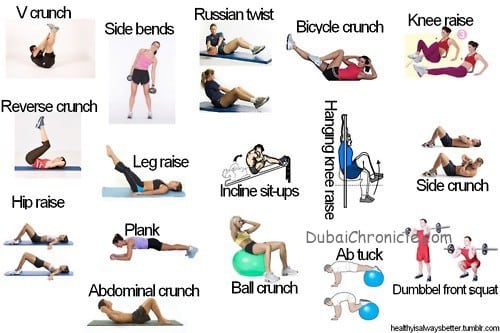How to get fab abs with our workout routine
Let’s start off with a harsh but simple truth. No matter how hard you work your tummy muscles, no matter how fantastic your core stability, how strong your six-pack — if you are carrying excess body fat, that impressive midriff will be hidden under a layer of flab. So while this workout will hone and tone, strengthen and flatten your abdominal muscles, it won’t melt away a spare tyre. For that, you need to look at your diet and overall physical activity levels, too.
That said, though, you will be amazed at the effect the flatter tummy workout will have on your midriff. Many of us get into a rut with our abdominal exercise regimes, doing the same old crunches and sit-ups every time, neglecting the muscles at the sides of the waist and the all-important ‘core’ muscles (the transversus abdominals), which lie deep below the surface and surround the lower trunk like a corset.
Bringing these muscles into the equation helps to nip in the waist and flatten the lower part of the tummy far more effectively than boring old curls and crunches. And believe me, you’ll certainly know you’ve done an abs workout the morning after your first session!
As well as using more of the musculature of the trunk, the workout is also highly efficient because it doesn’t just use one range of motion. Crunches and curls all involve flexing the trunk forward and rolling back, while lying on your back. Think about it. How often do you do that movement in daily life? Probably just the once, first thing in the morning when you get out of bed!
This routine works multi-dimensionally — by challenging the abs in all positions and through all planes of movement. For example, you’ll be working lying face down, on your side, even standing-up. The more directions you tackle your abs from, the more muscles you will use and the better the results will be.
You’ll notice that some of the exercises use a Swiss ball or medicine ball. All of them can be done without, except for the Jack-knife. It’s fine to improvise at first, but as you get more experienced, it will make the exercises more difficult if you use the right equipment. For example, the journal Physical Therapy found that curl-ups on the floor recruited 21 per cent of the rectus abdominis muscle (the six-pack), compared to 35 per cent on a Swiss ball.
Before we get started, here are some essential tips:
Make sure you have a mat, or a thick towel to exercise on, to protect the spine, knees and elbows.
To do the exercises correctly, you need to ‘engage’ the deep abdominal muscles. Imagine you are wearing a corset, which has a zip from the top of the pubic bone to the belly button. Take a breath, and as you exhale, slowly ‘do up’ the zip. When you get to the top, fasten the button (your navel) to an imaginary buttonhole on your spine. Maintain the contraction, but don’t hold your breath at any time.
Don’t ‘grip’ tightly around the midriff. You will find it hard to do any kind of movement if you are holding your tummy too tensely. To get the right level of tension, contract to your maximum, and then let the contraction go by 50 per cent.
Don’t try to flatten your back into the mat (or ball) when lying face up during exercises. As long as your navel is drawn to your spine, it doesn’t matter if there is a small curve at your lower back.
Work through the exercises slowly and breathe throughout. If possible try to exhale on the toughest bit of the exercise and inhale during the easier phase but if you find it difficult to coordinate, just breathe any old how!
Only perform the exercises every other day at most — three times a week is fine. Like any muscle, the abs need time to recover and develop between training sessions.
Follow the directions – when it says ‘pause’ in the exercise instructions, it means hold the position momentarily before returning to the start position. When it says ‘hold the position’ for a given period, it doesn’t mean hold your breath, too!
![]() For the first week, do routine A and routine B once each, to get a feel for the moves, and to prevent you ending up with muscle soreness that puts you off doing the workout again.
For the first week, do routine A and routine B once each, to get a feel for the moves, and to prevent you ending up with muscle soreness that puts you off doing the workout again.
Following that, add a second session of either routine. If you really want to go for it, do both routines twice a week, with a day-off between each. Start with one set of each exercise, increasing to two sets after four weeks, and three sets after eight weeks.






































